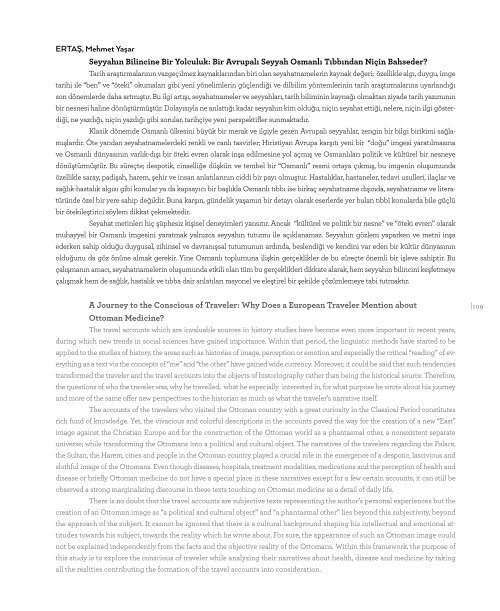14 - 17
MdZ0re
MdZ0re
Create successful ePaper yourself
Turn your PDF publications into a flip-book with our unique Google optimized e-Paper software.
ERTAŞ, Mehmet Yaşar<br />
Seyyahın Bilincine Bir Yolculuk: Bir Avrupalı Seyyah Osmanlı Tıbbından Niçin Bahseder?<br />
Tarih araştırmalarının vazgeçilmez kaynaklarından biri olan seyahatnamelerin kaynak değeri; özellikle algı, duygu, imge<br />
tarihi ile “ben” ve “öteki” okumaları gibi yeni yönelimlerin güçlendiği ve dilbilim yöntemlerinin tarih araştırmalarına uyarlandığı<br />
son dönemlerde daha artmıştır. Bu ilgi artışı, seyahatnameler ve seyyahları, tarih biliminin kaynağı olmaktan ziyade tarih yazımının<br />
bir nesnesi haline dönüştürmüştür. Dolayısıyla ne anlattığı kadar seyyahın kim olduğu, niçin seyahat ettiği, nelere, niçin ilgi gösterdiği,<br />
ne yazdığı, niçin yazdığı gibi sorular, tarihçiye yeni perspektifler sunmaktadır.<br />
Klasik dönemde Osmanlı ülkesini büyük bir merak ve ilgiyle gezen Avrupalı seyyahlar, zengin bir bilgi birikimi sağlamışlardır.<br />
Öte yandan seyahatnamelerdeki renkli ve canlı tasvirler; Hıristiyan Avrupa karşıtı yeni bir “doğu” imgesi yaratılmasına<br />
ve Osmanlı dünyasının varlık-dışı bir öteki evren olarak inşa edilmesine yol açmış ve Osmanlıları politik ve kültürel bir nesneye<br />
dönüştürmüştür. Bu süreçte; despotik, cinselliğe düşkün ve tembel bir “Osmanlı” resmi ortaya çıkmış, bu imgenin oluşumunda<br />
özellikle saray, padişah, harem, şehir ve insan anlatılarının ciddi bir payı olmuştur. Hastalıklar, hastaneler, tedavi usulleri, ilaçlar ve<br />
sağlık-hastalık algısı gibi konular ya da kapsayıcı bir başlıkla Osmanlı tıbbı ise birkaç seyahatname dışında, seyahatname ve literatüründe<br />
özel bir yere sahip değildir. Buna karşın, gündelik yaşamın bir detayı olarak eserlerde yer bulan tıbbî konularda bile güçlü<br />
bir ötekileştirici söylem dikkat çekmektedir.<br />
Seyahat metinleri hiç şüphesiz kişisel deneyimleri yansıtır. Ancak “kültürel ve politik bir nesne” ve “öteki evren” olarak<br />
muhayyel bir Osmanlı imgesini yaratmak yalnızca seyyahın tutumu ile açıklanamaz. Seyyahın gözlem yaparken ve metni inşa<br />
ederken sahip olduğu duygusal, zihinsel ve davranışsal tutumunun ardında, beslendiği ve kendini var eden bir kültür dünyasının<br />
olduğunu da göz önüne almak gerekir. Yine Osmanlı toplumuna ilişkin gerçeklikler de bu süreçte önemli bir işleve sahiptir. Bu<br />
çalışmanın amacı, seyahatnamelerin oluşumunda etkili olan tüm bu gerçeklikleri dikkate alarak, hem seyyahın bilincini keşfetmeye<br />
çalışmak hem de sağlık, hastalık ve tıbba dair anlatıları rasyonel ve eleştirel bir şekilde çözümlemeye tabi tutmaktır.<br />
A Journey to the Conscious of Traveler: Why Does a European Traveler Mention about<br />
Ottoman Medicine?<br />
The travel accounts which are invaluable sources in history studies have become even more important in recent years,<br />
during which new trends in social sciences have gained importance. Within that period, the linguistic methods have started to be<br />
applied to the studies of history, the areas such as histories of image, perception or emotion and especially the critical “reading” of everything<br />
as a text via the concepts of “me” and “the other” have gained wide currency. Moreover, it could be said that such tendencies<br />
transformed the traveler and the travel accounts into the objects of historiography rather than being the historical source. Therefore,<br />
the questions of who the traveler was, why he travelled, what he especially interested in, for what purpose he wrote about his journey<br />
and more of the same offer new perspectives to the historian as much as what the traveler’s narrative itself.<br />
The accounts of the travelers who visited the Ottoman country with a great curiosity in the Classical Period constitutes<br />
rich fund of knowledge. Yet, the vivacious and colorful descriptions in the accounts paved the way for the creation of a new “East”<br />
image against the Christian Europe and for the construction of the Ottoman world as a phantasmal other, a nonexistent separate<br />
universe; while transforming the Ottomans into a political and cultural object. The narratives of the travelers regarding the Palace,<br />
the Sultan, the Harem, cities and people in the Ottoman country played a crucial role in the emergence of a despotic, lascivious and<br />
slothful image of the Ottomans. Even though diseases, hospitals, treatment modalities, medications and the perception of health and<br />
disease or briefly Ottoman medicine do not have a special place in these narratives except for a few certain accounts, it can still be<br />
observed a strong marginalizing discourse in these texts touching on Ottoman medicine as a detail of daily life.<br />
There is no doubt that the travel accounts are subjective texts representing the author’s personal experiences but the<br />
creation of an Ottoman image as “a political and cultural object” and “a phantasmal other” lies beyond this subjectivity, beyond<br />
the approach of the subject. It cannot be ignored that there is a cultural background shaping his intellectual and emotional attitudes<br />
towards his subject, towards the reality which he wrote about. For sure, the appearance of such an Ottoman image could<br />
not be explained independently from the facts and the objective reality of the Ottomans. Within this framework, the purpose of<br />
this study is to explore the conscious of traveler while analyzing their narratives about health, disease and medicine by taking<br />
all the realities contributing the formation of the travel accounts into consideration.<br />
|109


